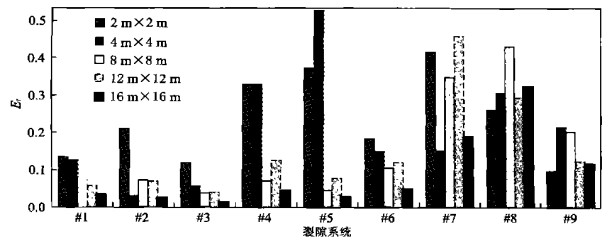Groundwater (Fluid) Flow Modeling in Fractured Rocks via Discrete Fracture Fluid Flow Approach
-
摘要: 流体渗流模拟的连续介质方法通常适用于多孔地质体, 并不一定适用于裂隙岩体, 由于裂隙分布及其特征与孔隙差异较大.若流体渗流主要受裂隙的控制, 对于一定尺寸的裂隙岩体, 多孔介质假设则较难刻划裂隙岩体的渗流特征.离散裂隙渗流方法不但可直接用于模拟裂隙岩体非均质性和各向异性等渗流特征, 而且可用其确定所研究的裂隙岩体典型单元体及其水力传导(渗透)张量大小.主要讨论了以下问题: (1)饱和裂隙介质中一般的离散流体渗流模拟; (2)裂隙岩体中的REV(典型单元体)及其水力传导(渗透)张量的确定; (3)利用离散裂隙网络流体渗流模型研究裂隙方向几何参数对水力传导系数和REV的影响; (4)在二维和三维离散裂隙流体渗流模型中对区域大裂隙和局部小裂隙的处理方法.调查结果显示离散裂隙流体渗流数学模型可用来评价不同尺度上的裂隙岩体的水力特征, 以及裂隙方向对裂隙化岩体的水力特征有着不可忽视的影响.同时, 局部小裂隙、区域大裂隙应当区别对待, 以便据其所起的作用及水力特征, 建立裂隙化岩体相应的流体渗流模型.Abstract: The continuum approach in fluid flow modeling can generally be applied to porous geological media, but has limited applicability for fractured rocks. With the presence of a complex fracture network pattern and the fluid flow restricted mainly to the fractures, the porous media assumption does not adequately describe the flow behavior in the fractured rocks. A discrete fracture flow model has the capability not only in capturing inhomogeneity and anisotropy, but also in estimating representative elementary volume (REV) and determining hydraulic conductivity tensor for fractured rocks. In this paper, the following sub topics were discussed: (a) general discrete fracture fluid flow modeling for saturated fractured geologic media; (b) determinations of REV and hydraulic conductivity tensor for fractured rocks using a discrete fracture network fluid flow model; (c) investigations of fracture orientation effect on the hydraulic conductivity and REV using a discrete fracture network fluid flow model, and (d) the ways to treat major fractures vs. minor fractures in the 2D and 3D discrete fracture fluid flow models. The results from this investigation indicate that a discrete fracture flow model could be used to evaluate the hydraulic properties at different scales. In addition, the orientation of fractures plays an important role in determining the hydraulic behaviors in fractured rocks. Furthermore, various conceptual fluid flow models are presented to reflect the different flow features of both minor and major fractures identified in fractured rock masses.
-
表 1 裂隙网络的配置关系
Table 1. Configurations of fracture sets

-
[1] Hsieh P A, Neuman S P. Field determination of the three-dimensional hydraulic conductivity tensor of anisotropic media, 1, Theory[J]. Water Resources Research, 1985, 21(11): 1655-1665. doi: 10.1029/WR021i011p01655 [2] Hsieh P A, Neuman S P, Stiles G K, et al. Field determination of the three-dimensional hydraulic conductivity tensor of anisotropic media, 2, methodology and application to fractured rocks[J]. Water Resources Research, 1985, 21(11): 1667-1676. doi: 10.1029/WR021i011p01667 [3] Kanatani K. Distribution of directional data and fabric tensors[J]. Int J Engrg Sci, 1984, 22(2): 149-164. doi: 10.1016/0020-7225(84)90090-9 [4] Kulatilake P H S W, Wang M, Um J, et al. Software package for FRACNTWK—a computer package to model discontinuity geometry in rock masses[CP]. Submitted to Metropolitan Water District of Southern California, Los Angeles, CA, 90071-3123, USA. [5] Kulatilake P H S W, Wathugala D N, Stephansson O. Joint network modeling with a validation exercise in Stripa Mine, Sweden[J]. Int J Rock Mech Min Sci & Geomech Abstr, 1993, 30(5): 503-526. [6] Oda M. Permeability tensor for discontinuous rock masses [J]. Geotechnique, 1985, 35(4): 483-495. doi: 10.1680/geot.1985.35.4.483 [7] Panda B B, Kulatilake P HS W. Influence of discontinuity geometry parameters and transmissivity on hydraulic behavior of discontinuous rock[J]. Jour of Engrg Mech, 1999, 125(1): 41-50. doi: 10.1061/(ASCE)0733-9399(1999)125:1(41) [8] Panda B B, Kulatilake P HS W. Relations between fracture tensor parameters and permeability tensor parameters for discontinuous rock[J]. Jour of Engrg Mech, 1999, 125(1): 51-59. doi: 10.1061/(ASCE)0733-9399(1999)125:1(51) [9] Wang M, Kulatilake P H S W, Um J. Estimation of REV size and three-dimensional hydraulic conductivity tensor for a rock mass through discrete fracture fluid flow modeling[A]. In: Girard J, Liebman M, Breeds C, et al. Proceedings of 38th U.S. Rock Mechanics Symposium[C]. Washington, DC, USA: Balkema A A/Rotterdam/Brookfield, 2001. [10] Wang M, Kulatilake P H S W, Panda B, et al. Groundwater resources evaluation case study via fracture fluid flow modeling[J]. An International Journal: Engineering Geology, 2001, 62(4): 267-291. doi: 10.1016/S0013-7952(01)00029-1 [11] Wang M. Investigation of hydraulic behaviors for fluid flow in fractured rocks based on fracture geometry parameters[J]. American Geophysical Union, 2000, 81 (48): 409. [12] Wang M, Kulatilake P H S W. Discrete fracture fluid flow simulation of pumping testsin a fractured rock mass [A]. Proceedings of the Fourth North American Mechanics Symposium[C]. Seattle, Washington, USA: American Rock Mechanics Association, 2000. 831-839. [13] Wang M. Discrete fracture fluid flow modeling and field applications in fractured rocks[D]. Tucson, Arizona, USA: The University of Arizona, 2000. 303. -










 下载:
下载:



